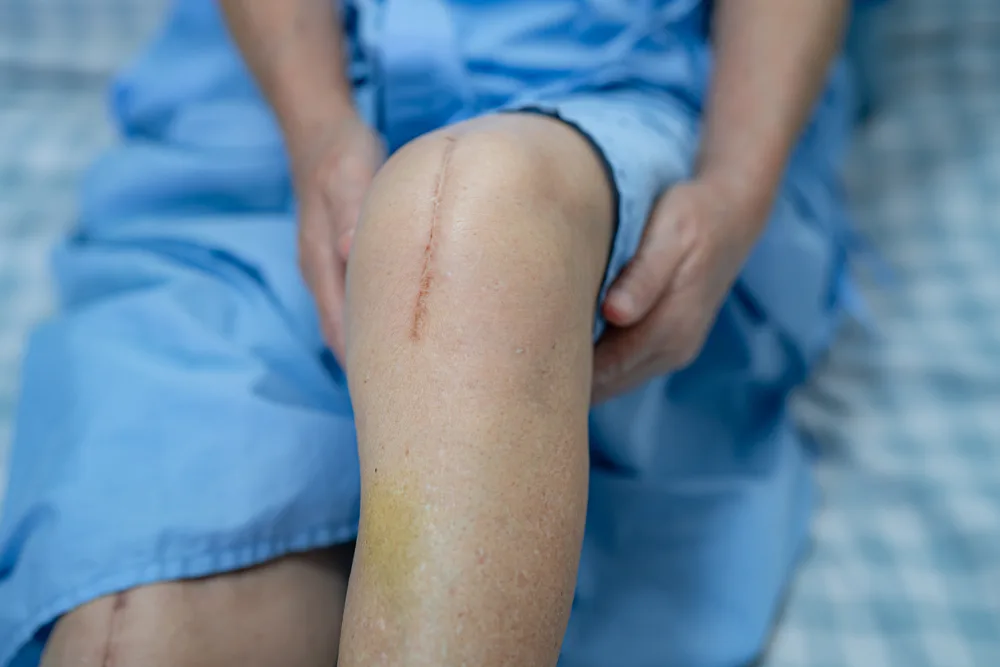
Bowlers of all ages often face the question of whether or not to continue bowling after they have had a knee replacement. Many people are unsure if they will be able to still bowl with their new knee and what the experience will be like.
In this blog post, we will explore everything you need to know about bowling after getting a knee replacement. We will look at how your new knee can impact your ability to bowl as well as some tips to make the experience a little easier.
Keep reading for more information!
Contents
- 1 Can You Bowl With a Knee Replacement?
- 2 Is It Safe to Go Bowling After a Total Knee Replacement?
- 3 Activities to Do to Improve Your Bowling Skills After My Knee Replacement?
- 4 What Activities Should You Avoid After Knee Replacement?
- 5 Can You Damage a Knee Replacement During Bowling?
- 6 How Long Does One Take To Recover After Total Knee Replacement?
- 7 Should I Do Physiotherapy After a Total Knee Replacement Before Returning to Bowling?
- 8 How Long Will My Knee Replacement Last When Bowling Regularly?
- 9 Can I Join a Professional Bowling League After Knee Replacement?
Can You Bowl With a Knee Replacement?
It depends on the type of knee replacement surgery you had, your overall health, and your surgeon’s recommendations. If you had a total knee replacement, it’s likely that your doctor will advise against bowling. However, if you had a partial knee replacement or a minimally invasive knee surgery, you may be able to bowl with some precautions.
According to the National Institutes of Health, more than 700,000 Americans undergo knee replacement surgery each year. The procedure is typically recommended for people who have severe arthritis or other joint damage. While knee replacement surgery can provide relief from pain and improve mobility, it’s not without its risks.
One of the potential complications is instability in the replaced joint, which can make it difficult to maintain balance and put unnecessary stress on the surrounding muscles and tissues. For this reason, many doctors recommend avoiding high-impact activities such as running or jumping.
You’ll need to use a light ball and avoid putting too much spin on it be careful when releasing the ball and avoid any sudden movements that could put a strain on your joint.

Is It Safe to Go Bowling After a Total Knee Replacement?
Bowling is a low-impact activity, and for many people, it is a fun and relatively gentle way to spend some time with friends. But for those who have undergone a total knee replacement, probably after a torn ACL, it’s important to understand the risks before heading to the lanes.
The most significant risk is that of falling. Because the knee is still healing, it may not be as strong as it was before the surgery. This can make it difficult to maintain your balance, especially when wearing Bowling shoes. In addition, the repeated twisting and turning required to bowl can put undue stress on the knee, which could lead to dislocation.
According to Dr. Haverbush, it is safe to bowl after partial knee replacement. However, you’ll be required to use lighter bowling balls. He recommends that in both scenarios, either if you’ve undergone a total or partial knee replacement, you should use a knee brace for knee support.
Overall, it’s important to consult with your doctor before hitting the lanes after a total knee replacement. With their guidance, you can make sure that you stay safe while still enjoying your favorite pastime.
Activities to Do to Improve Your Bowling Skills After My Knee Replacement?
As a close friend of someone who recently underwent knee replacement surgery, you may be wondering what activities you can do to help improve your bowling skills.
First and foremost, it is important to focus on regaining your range of motion. This can be done by doing some simple stretches and exercises regularly. It is also important to work on your flexibility and balance. Pilates or yoga classes can be helpful for this.
In addition, it is important to build up your strength, particularly in your legs and core. This can be done by lifting weights or working with a physical therapist.
Finally, make sure to practice regularly! The more you bowl, the better you will become at it.
Other activities you can do are:
- Walking
- Slow dancing
- Cycling (as advised by your therapist)
- Low impact aerobics
- Croquet
- Shuffleboard
- Horseshoes
Once you’ve gained some pace, you can get involved in the following activities:
- Hiking
- Rowing
- Cross country skiing
- Weight training
- Ice skating
- Non-competitive tennis
- Competitive bowling
By following these simple tips, you can help improve your bowling skills after surgery.

What Activities Should You Avoid After Knee Replacement?
Knee replacement surgery is a common and successful procedure that can relieve pain and improve function in people with knee joint damage. However, it’s important to understand that this surgery does not completely cure the underlying condition.
As a result, it’s important to take care of your new knee and avoid activities that could put undue stress on the joint. High-impact activities like jogging and running, volleyball, basketball, and football are typically off-limits after knee replacement surgery.
Instead, your doctor will likely recommend lower-impact activities such as walking, swimming, and biking, as mentioned above. It’s also important to avoid sudden movements or deep squats, which can put stress on the joint and lead to the displacement of the implant.
Other activities to keep off from are:
- Rock climbing
- Soccer
- Singles tennis
- Gymnastics
- Skiing
- Hockey
- Rollerblading
- Inline Skating
With a little care and caution, you can protect your new knee and enjoy an active lifestyle.
Can You Damage a Knee Replacement During Bowling?
After the surgery, it’s important to avoid activities that could put too much stress on the joint, resulting in damage. So, what about bowling? Is it safe for people with knee replacements?
The good news is that bowling is generally a safe activity for people with knee replacements. The slow, controlled movements required for bowling are unlikely to put too much strain on the joint. However, it’s still important to take things easy at first and listen to your body.
If you start to feel any pain or discomfort, stop bowling and consult your doctor so that you enjoy this fun activity without damaging your new knee joint.
How Long Does One Take To Recover After Total Knee Replacement?
It varies from person to person. However, there are some general guidelines that can give you an idea of what to expect. Most people report feeling significant pain relief within the first 3 to 6 weeks after surgery.
This will enable you to perform light activities as you should be able to start bearing weight on your new joint and begin physical therapy. Most people are able to return to their normal activities within 6 to 12 months. Of course, it will take some time to regain your full strength and range of motion.
But overall, most people find that they have a significant improvement in their quality of life after total knee replacement surgery.
Should I Do Physiotherapy After a Total Knee Replacement Before Returning to Bowling?
A total knee replacement (TKR) is a major surgery that requires a lengthy recovery process. John Hopkins requires patients to participate in physiotherapy after their surgery. Physiotherapy can help to improve the range of motion, increase muscle strength, and decrease pain and swelling.
It can also help to improve your overall mobility and function. All of these factors can be extremely helpful when it comes time to return to bowling. While you may not be able to bowl at your usual level immediately after surgery, physiotherapy can help you make a successful and safe return to the game.
How Long Will My Knee Replacement Last When Bowling Regularly?
In general, people who have knee replacements can expect their new joint to last 15-20 years. However, this may vary depending on individual factors such as age, weight, and activity level. People who engage in high-impact activities such as running or jumping are more likely to experience wear and tear on their artificial joints, which can shorten the lifespan of the replacement.
Bowling is a relatively low-impact activity, so it is unlikely to cause significant damage to a knee replacement. However, it is important to consult with your doctor before returning to any regular exercise after surgery. They will be able to advise you on when it is safe to start bowling again and how many times per week you should bowl in order to avoid overstressing your new knee.
Can I Join a Professional Bowling League After Knee Replacement?
Knee replacement surgery does not have to end your bowling career. You will need to get clearance from your doctor before returning to any type of physical activity, as you may need to make some adjustments to your bowling style in order to protect your new knee.
While bowling may not be as strenuous as other sports, it still requires some physical activity.
Related Articles
- Common Bowling Injuries
- Forearm Sore After Bowling
- Activities to Avoid With Hernia
- Bowling Ring Finger Pain
Most people who have had a knee replacement can bowl. However, you may need to make some adjustments to your technique. For example, you may need to use a lighter ball or lower your grip point. You may also need to keep your feet closer together when you bowl.
If you are having difficulty standing up straight, you can use a support like a bowling ramp. Talk to your doctor or physiotherapist about ways to stay safe and protect your new knee while bowling. With a little bit of practice, you should be able to bowl with a knee replacement just like you did before.
Here’s a full guide with the steps and guidelines to improve your daily life after knee replacement.
Kira Byrd, a Certified Fraud Examiner, holds a B.S. in Accounting from the University of Alabama at Birmingham. With a passion for bowling from her childhood, Kira has poured her expertise and personal experiences into creating and nurturing Bowling For Beginners. Kira’s mission is to meet new bowlers where they are and guide them toward consistently achieving higher scores. With a focus on skill development and strategic techniques, she empowers readers to take control of their game and unlock their true potential.
Bowling For Beginners embodies strict editorial integrity, ensuring reliable and unbiased information. Kira’s commitment to delivering valuable insights and practical strategies is reflected in every article. Here’s an explanation of our editorial policy and how we get money.


Hey Twicsy, I am glad that you found this article to be helpful. In deed it is one of the many health related questions that many bowlers are curious to learn about.
And thanks for your comment about the user experience the site design has to offer 😊
I believe this is one of the such a lot vital information for me.
And i am satisfied studying your article. But should remark on some common issues, The site style is ideal,
the articles is in reality great : D. Good task, cheers